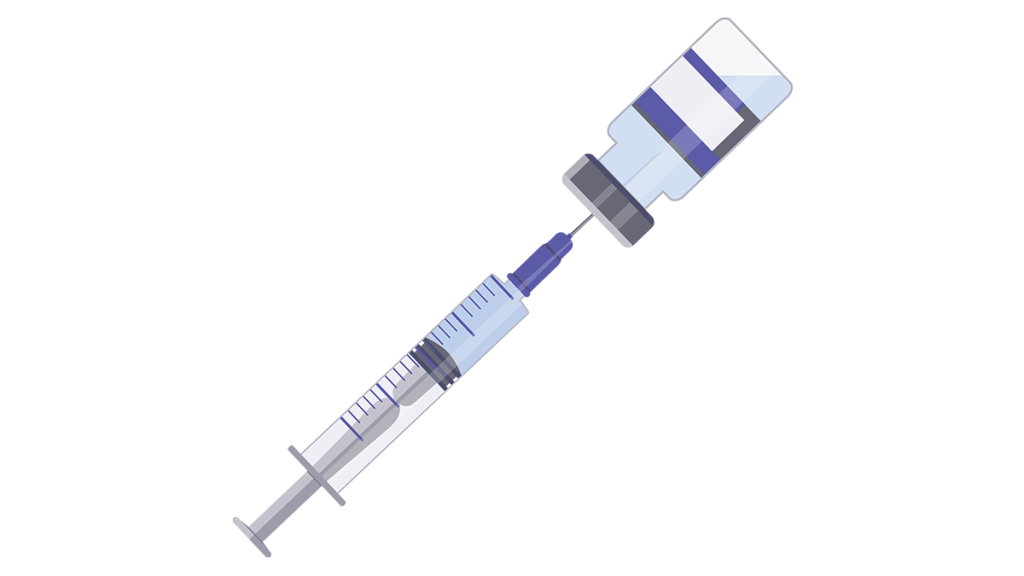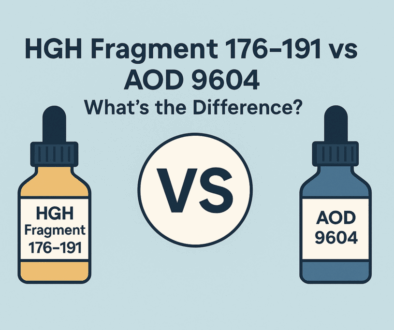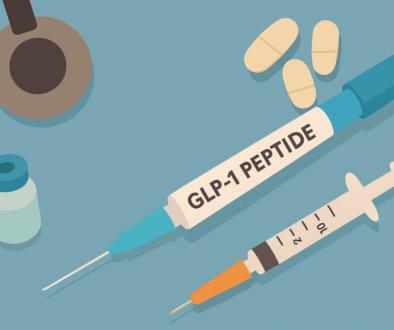Peptide Reconstitution Guide

Reconstituting research peptides is a crucial step in scientific experiments involving these versatile molecules. Proper reconstitution ensures the peptides are in a usable form, maintaining their stability and effectiveness for accurate results.
This article will guide you through the process, covering the essential materials, step-by-step instructions, and best practices for storage and handling.
Quick Summary:
- Properly reconstituting peptides is essential for maintaining their stability and effectiveness, ensuring accurate results in your research.
- In most cases, it’s enough to reconstitute peptides with 1-2 ml of bacteriostatic water and gently shake them to ensure they’re fully dissolved.
- Reconstituted peptides will be stable for about 30 days in the fridge, and much longer when stored long-term in a freezer.
Table of Contents
Understanding Research Peptides
What are Research Peptides?
Peptides are short chains of amino acids linked by peptide bonds, playing key roles in various biological processes.
Research peptides are used specifically for scientific research, such as understanding cellular mechanisms, developing new therapies, and exploring biological functions.
Preparation Before Reconstitution
Materials and Equipment Needed
Before reconstituting research peptides, gather the necessary materials and equipment to ensure a smooth and sterile process:
- Peptide Vial: The vial containing the lyophilized (freeze-dried) peptide.
- Solvent: Typically bacteriostatic water (or other suitable solvents).
- Syringes: Sterile syringes with needles for drawing and transferring the solvent.
- Alcohol Swabs: For sterilizing the syringe needles, vial’s rubber stopper, and other surfaces.
- Protective Gear: Gloves and possibly a lab coat to maintain sterility and safety.
Importance of Sterile Equipment
Using sterile equipment is crucial to prevent contamination, which can compromise the integrity of the peptide and the accuracy of your experiments. Always ensure that all materials are sterile and handle them with care to maintain a clean working environment.
Contamination can lead to inaccurate results, wasted materials, and potential safety hazards, making sterility a top priority in peptide reconstitution.

Step-by-Step Reconstitution Process
Choosing the Solvent
- Solubility: Ensure the peptide is soluble in the chosen solvent. Sterile water or bacteriostatic water is commonly used, but some peptides, like AOD9604, may require specific solvents like acetic acid or dimethyl sulfoxide (DMSO).
- Stability: The solvent should maintain the peptide’s stability. Some peptides are more stable in acidic or basic conditions, so adjust the pH accordingly.
- pH: The pH of the solvent can affect peptide stability and solubility. Check the peptide’s datasheet for recommended pH levels.
Reconstitution Procedure
Follow these steps to reconstitute your peptide:
- Sterilize Your Work Area: Clean your workspace and sterilize your equipment to prevent contamination. Use alcohol swabs to wipe down the vials and needles.
- Prepare the Solvent: Draw the appropriate amount of solvent into a sterile syringe. The volume depends on the peptide concentration you need, but typically amounts of 1-2 ml are used.
- Add Solvent to the Peptide Vial: Carefully inject the solvent into the vial containing the lyophilized peptide. Aim the solvent against the side of the vial to minimize foaming and ensure gentle mixing.
- Dissolve the Peptide: Gently swirl the vial to mix the solvent and peptide. If the peptide does not dissolve completely, allow it to sit at room temperature for a few minutes and gently swirl again.
- Check for Complete Dissolution: Inspect the solution to ensure the peptide is fully dissolved. There should be no visible particles or clumps. If necessary, adjust the solvent volume or type to achieve complete dissolution.
By following these steps, you can ensure that your peptide is properly reconstituted and ready for use in your research experiments.
Storage and Handling of Reconstituted Peptides
Proper Storage Conditions
Once reconstituted, peptides must be stored correctly to maintain their stability and effectiveness:
- Short-term Storage: For immediate use, store the reconstituted peptide at around 4°C (39°F) in a refrigerator. This is suitable for peptides that will be used within a few days, although they will remain stable for about 30 days before beginning to slowly degrade.
- Long-term Storage: It’s best to keep reconstituted peptides in the fridge and use them within 30-60 days, because repeated thawing and freezing can damage the peptide. But if you don’t have a choice, divide the reconstituted peptide into smaller portions (aliquots) and keep them in the freezer, ideally at -20°C (-4°F) or -80°C (-112°F). Still, it’s best to keep peptides frozen in their dry, lyophilized form rather than reconstituted, as they will remain stable for years.
Avoiding Degradation
To prevent peptide degradation:
- Protect from Light: Some peptides are sensitive to light and should be stored in dark vials or wrapped in aluminum foil.
- Minimize Freeze-Thaw Cycles: Repeated freezing and thawing can degrade peptides. Use aliquots to reduce the need for multiple cycles.
Handling Reconstituted Peptides
Proper handling of reconstituted peptides is crucial for maintaining their integrity:
- Use Sterile Techniques: Always handle peptides with sterile gloves and equipment to avoid contamination.
- Label Clearly: Label each vial with the peptide name, concentration, and date of reconstitution to keep track of your samples.
- Thawing: When ready to use, thaw peptides slowly at room temperature or in a refrigerator. Do not use a microwave or other rapid heating methods.
By following these storage and handling guidelines, you can ensure that your reconstituted peptides remain stable and effective for your research purposes.
Troubleshooting Common Issues
Common Problems and Solutions
Even with careful preparation, you might encounter issues during peptide reconstitution. Here are some common problems and their solutions:
- Incomplete Dissolution:
- Problem: The peptide does not fully dissolve, leaving visible particles.
- Solution: Check if the solvent is appropriate for your peptide. If not, try using a different solvent or adjust the pH. Allow the vial to sit at room temperature and gently swirl again. If necessary, briefly heat the solution in a water bath at a controlled temperature (avoid overheating).
- Peptide Precipitation:
- Problem: The peptide precipitates out of solution after reconstitution.
- Solution: Ensure the peptide is stored at the correct temperature. If precipitation occurs, gently warm the solution and swirl to redissolve the peptide. Consider adjusting the solvent or adding a small amount of acetic acid or other suitable additives to improve solubility.
- pH Issues:
- Problem: The pH of the solution is not optimal for peptide stability.
- Solution: Adjust the pH of the solvent before reconstitution, using buffers or pH modifiers as needed. Check the peptide datasheet for recommended pH levels.
- Contamination:
- Problem: The reconstituted peptide solution becomes contaminated.
- Solution: Ensure all equipment and materials are sterile before starting the reconstitution process. Use aseptic techniques and handle the peptides in a clean environment. If contamination is suspected, discard the solution and start with a new vial.
Ensuring Stability and Activity Over Time
To maintain the stability and activity of reconstituted peptides over time, follow these best practices:
- Regularly Check for Degradation: Monitor the appearance of the peptide solution. If you notice any changes in color, clarity, or the presence of particles, it may indicate degradation.
- Use Freshly Reconstituted Peptides: Whenever possible, use freshly reconstituted peptides to ensure maximum activity and accuracy in your experiments.
- Test Aliquots Periodically: For long-term storage, periodically test small aliquots to ensure the peptide remains stable and effective.
By troubleshooting common issues and following these guidelines, you can ensure the successful reconstitution and long-term usability of your research peptides.
Safety and Precautions
Safety Measures
Working with peptides requires strict adherence to safety protocols to protect both the researcher and the integrity of the experiment. Here are some essential safety measures to follow:
- Personal Protective Equipment (PPE): Always wear appropriate PPE, including gloves, lab coat, and safety goggles, to protect yourself from exposure to peptides and solvents.
- Sterile Environment: Work in a clean, sterile environment, such as a laminar flow hood or a designated clean bench, to prevent contamination of the peptides.
- Proper Disposal: Dispose of used materials, such as syringes and needles, in designated biohazard containers. Follow your institution’s guidelines for the disposal of chemical and biological waste.
Bringing It All Together
Proper reconstitution of research peptides is essential for obtaining accurate and reliable results in your experiments. By preparing the necessary materials, following a meticulous reconstitution process, and adhering to storage and handling best practices, you can ensure the integrity and effectiveness of your peptides.
Additionally, being aware of common issues and troubleshooting them effectively, along with following stringent safety measures, will further enhance the quality of your research.
Join Our Newsletter — Get 15% Off
Get the latest offers, peptide research insights, and stock updates.



